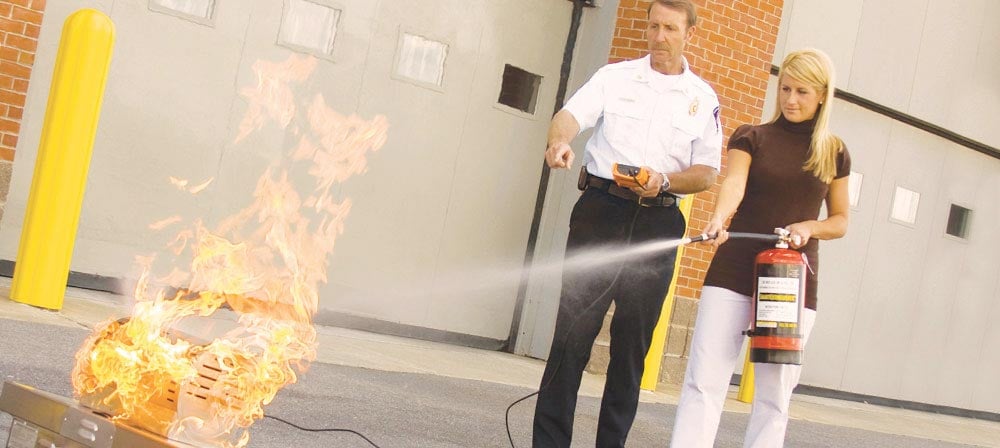Imagine an employee is heating their lunch in the office kitchen and becomes distracted when a coworker pulls them away. When they return to the kitchen, their appliance has caught fire, and they panic.
This is my fault, they think. I'm going to be in so much trouble. I have to do something.
They begin swatting at the flames with a kitchen towel, but the towel catches fire and burns their hand. Finally, they yank the portable fire extinguisher from its place. The fire begins creeping up the kitchen's back wall as they struggle to pull the pin. The employee aims the extinguisher — but they've never been trained to use it and are too close to the flames.
Just like that, an employee is in the hospital.
Will this exact scenario happen at your business? Probably not. But even in relatively low-risk work environments such as offices, there is always a possibility that something similar could happen.
That’s why the Occupational Safety and Health Administration (OSHA) mandates that employers provide fire extinguishers based on the classes of anticipated fires—and provide education on their proper use.
Let’s take a closer look at the OSHA requirements for fire extinguisher training.
Understanding OSHA Workplace Fire Extinguisher Training Requirements
To most businesses, it is common knowledge that employers must provide portable fire extinguishers, keep them in an accessible location, and maintain them so that they are fully charged and operable at all times.
Many people miss that, when extinguishers are provided in a workplace, OSHA fire extinguisher training requirements state that employees must be trained yearly.
Here are the OSHA guidelines that specify the employee fire extinguisher training requirements.
1910.157(g)(1)
Where the employer has provided portable fire extinguishers for employee use in the workplace, the employer shall also provide an educational program to familiarize employees with the general principles of fire extinguisher use and the hazards involved with incipient stage fire fighting.
1910.157(g)(2)
The employer shall provide the education required in paragraph (g)(1) of this section upon initial employment and at least annually thereafter.
That's a bit unclear. What does OSHA mean by "educational program?" And does "education" require hands-on training?
The definitions for Subpart L that appear in 1910.155, paragraph (c)(14) define education as: "the process of imparting knowledge or skill through systematic instruction. It does not require formal classroom instruction."
So, at the bare minimum, employers must provide workers with instructions on general fire extinguisher use and the hazards associated with fighting incipient-stage (beginning-stage) fires. Unfortunately, the bare minimum doesn't save lives and property. Employees need to be trained in proper workplace fire safety, not merely educated with a pamphlet.
Hands-On Training: Going Beyond the Bare Minimum
Many companies create policies forbidding the use of fire extinguishers for their employees, figuring that the company evacuation plan is enough. Then, they believe they don’t need to train their employees on how to use a fire extinguisher. Unfortunately, those policies will never hold up.
It’s reasonable to assume that an employee will attempt to fight the fire with an extinguisher when faced with a life-threatening fire. Suppose an employee chooses to discharge an extinguisher in the face of a fire. In that case, it is their choice to protect themself — not the company. The lives of your employees are worth more than a policy.
For that reason, it's important to put employees through live fire training to familiarize them with the risks and responsibilities associated with incipient-stage fire-fighting and allow them to discharge a fire extinguisher on a fire. Only with hands-on experience can employees be trained to act quickly when faced with a workplace fire.
Save Lives and Reduce Property Damage with Fire Extinguisher Training
Fires are inherently unpredictable. A comprehensive fire extinguisher training program ensures your employees will know how to combat an emergency effectively. Fire extinguisher training requirements are more than simply fulfilling some OSHA mandates — they empower your employees to decide whether to fight the fire or get themselves out.
Businesses interested in fire extinguisher training should partner with a qualified fire protection company. Certified instructors will provide in-depth classroom education and hands-on training that meets OSHA requirements.
Editor's Note: This post was originally published on September 20, 2016, and has been updated for accuracy and current best practices.








